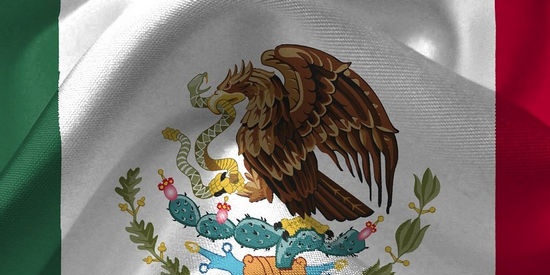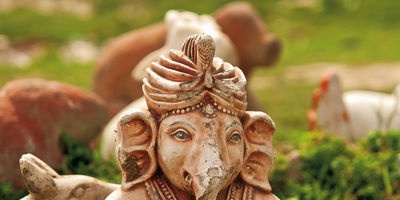Hamadrills: sounds, facial expressions, gestures |
|
The fact is that in the modern sense, the language of animals is a communication system that can include not only acoustic signals. This also includes gestures, postures, and the system of communication with the help of drawings, flowers, smells, etc., etc. - in a word, all possible means that help to establish contact between individual animals, to coordinate the actions of the entire community The language of hamadryas includes a complex system of sounds, looks and gestures.
The leader, who noticed the danger, makes a special exclamation. There is no need to repeat a second time: the whole herd immediately rushes away or takes a defensive position. The monkey, lagging behind the herd, screams differently. And completely different sounds accompany various intra-herd rituals that help hamadryas to express their attitude towards their fellow tribesman. Any member of the hamadryas herd, meeting a leader or a monkey of the highest rank, will sit down in front of it and several times abruptly "gasp". This is a message of obedience, recognition of authority and admiration for it. When offering his services for searching, the monkey will first use his tongue in a special way - a signal to his partner about a friendly disposition and a request to respond in kind. A variation on this sound is the gentle babble that any monkey "Addresses" to the baby, going to give him a ride or just nurse. If we draw an analogy with the human language - a very conditional analogy - the signals in the hamadryll language correspond not to words, but to phrases, sometimes even to a whole set of phrases.
Silent means of communication - postures, gestures, facial expressions - constitute the second and perhaps the most expressive part of the hamadryas language. One and a half dozen expressive glances, mimic movements and signaling gestures, in addition to twenty sound signals, is quite enough to “explain” with relatives and enemies on any topic. Standard situation. Two females quarreled. Screeching. Wool in shreds. And suddenly the one who started the fight catches the leader's gaze on herself. Squealing as if she was rewarded not with a glance, but with a good slap, the monkey rushes to the master and begins to search him nervously. Actually, this is not even a search, but several searching movements. Purely symbolic. In order to prove your loyalty and be forgiven.
Warring females often use menacing looks during silent squabbles. They blink at each other, satisfy their anger and disperse, without attracting the attention of the leader. It seems that Heidiger, a famous ethologist, owns the phrase that the body of an animal is like an open book, which can be read if you know how to read, and that each point of the body has its own meaning within the herd. This fits the hamadryas as well as possible.
Raising the tail in a certain way and waving it from side to side, the hamadrilich can demonstrate his favor for the male or express complete disregard for his courtship. Experiencing the forbidding gaze of a stronger monkey, a weak one will certainly fold his hands in a special way - press them to the body, and lower his hands. A gesture showing obedience, obedience. But, perhaps, in the first place in the communication of monkeys - all the same facial expressions. The richness of facial expressions is the result of the well-developed facial muscles in these monkeys. By moving their ears, eyes, mouth, scalp, hamadryas can demonstrate fear, rage, curiosity, indecision, cheerful mood, anger, sadness, and many shades of emotion. Especially if there is a "struggle of motives" in the hamadryll creature.
Even babies know this law of the hamadryas herd. But the delicacy remains a delicacy. And a whole gamut of feelings will be reflected on the monkey's face: the desire to grab food, fear of the leader, an attempt to demonstrate obedience, indecisive insolence in the hope of snatching a piece and remaining unpunished. But, perhaps, the most expressive feelings are written on the physiognomy of a hamadryl male, when he sees an opponent and does not have the opportunity to grapple with him. The ultimate expression of such emotions is ... yawning. These yawns are terrible and passionate. Show all teeth, gums, pharynx. Closed eyes, drawn ears, tense body only emphasize the strongest degree of arousal in which the rivals are. And after each such yawn, the monkey is like after a severe nervous attack. Although, perhaps, this is the case, if we agree with ethologists and classify such behavior of hamadryas as biased reactions, which are always the result of extreme emotional stress.
Who are hamadryas?Hamadrils (frilled baboons) are narrow-nosed monkeys. They belong to the genus of ordinary baboons. This genus is included in the family of the lower narrow-nosed, or monkey-like, monkeys, and this family, in turn, is part of the superfamily of dog-like monkeys. Hamadrilas do look like dogs. Both in appearance and in some of the sounds reminiscent of a dog barking. In Greece and in ancient Rome they were called so - cynocephalic (dog-headed). This name is still used occasionally. Hamadryas are also called frilled baboons.They owe this name to the luxurious silvery-gray mantle that covers the shoulders of adult males. By the way, if you come across a description of silver baboons in old books, we are again talking about hamadryas. There are hamadryas (Papio hamadryas) in East Africa and the Arabian Peninsula. These are large monkeys. The weight of males sometimes reaches 40 kilograms. Females are smaller. And they give birth to babies in general tiny. Usually one cub is born, but twins also happen. There is no seasonality in breeding for hamadryas. Hamadryas live in herds of fifty - sixty, or even eighty monkeys.
Not all parts of their possessions are visited by hamadrils with the same constancy. In some they spend most of their time, in others they don’t spend months. The hamadryas have favorite feeding and midday resting places, certain overnight places. The herd of hamadryas is united in their actions. The monkeys feed together, go to the watering place, and return for the night. And, of course, they fight off enemies together. This coherence, organization in actions is possible only because within the hamadryas herd there is a complex system of relationships between its individual members. There were different versions regarding the structure of the hamadryas herd. According to one of them, the herd is the "harem" of one and only seasoned leader. All other monkeys are his wives and children. In such a herd, females are faithful to their master all their lives. The grown-up sons, becoming rivals of the father, are expelled from the herd. Some of the females leave with them. According to another hypothesis, the entire hamadryas community consists of several o and k and a, ruled by one or more large leaders. Oikia is a kind of monkey family. It includes females with calves and several males. By For the first time the term "oikia" was introduced into primatological literature by the Japanese scientist Ima-n-ishi. Imanishi believes that there are two types of oikia. Some oikia exist in isolation, not merging with neighboring ones and not allowing them to enter their territory. Oikia of the second type coexist peacefully, forming huge herds. At the head of such herds is a leader or several leaders.
It turned out, however, that the hamadrilles are a herd and not a harem or a group of Oikia. It seems that a special name for this kind of communities has not yet been thought up. But the types of relationships that exist in the herd, which allow it to be preserved as a whole, are quite clearly traced. Like all herd animals, the hamadryas have a hierarchy. Hierarchy is a phenomenon common to all species, without exception, be it large herds of mammals, a flock of hens or a colony of crickets. The essence of this phenomenon is that in any of the communities it is always possible to single out a leader (an alpha animal), to whom all other tribesmen obey. He has the right to be the first in the choice of food and the female. It is followed by the lowest ranked animal beta, inferior in everything to the leader, but not giving descent to everyone else. This is followed by animals such as gamma, delta, etc., up to the omega, which obeys all members of the herd. He is constantly persecuted. Trying to explain this phenomenon, some researchers associate the rank of the animal in the herd hierarchy with the degree of development of the gonads. Be that as it may, as a rule, the largest and strongest males occupy a dominant position. Hamadrils in this sense are no exception. At the head of the herd, hamadryas are always the strongest and most often the oldest male. Sometimes there are several leaders - then they are equal to each other.They equally care about the safety of the herd, about the order within it. All other monkeys are located on various steps, a hierarchical ladder. The stronger and larger the animal, the higher its rank. This principle fully applies only to males. Females have their own hierarchy, parallel to that of males. The rank of a female is not determined by her strength.
This happens when the tyranny of females begins to disturb the peace of the herd. Another principle on the basis of which ranks are distributed among hamadryls is the presence of a cub. The most seedy female with the birth of a cub is immediately automatically transferred to a higher rung of the hierarchical ladder. The laws of hierarchy do not apply to babies during the first few months of life. The very birth of a hamadrylenka is an event. Monkeys in a tight crowd surround the woman in labor, worry, shout. When childbirth ends safely, everyone tries to look or touch the newborn, witnessing a tender attitude towards him. However, rarely anyone succeeds, because a happy mother immediately he hurries to hide his treasure from the cold and from unnecessary glances on his chest. Only in the third week of life does the hamadrylenki come out to look at the white light. Unable to keep him on his chest, the hamadrilikha holds his tail, allowing him to explore the world within the radius of this peculiar leash. Now access to the baby is open to everyone. Small hamadryats are the center of attraction for the whole herd. Even the slightly ahead of them, their teenagers, gently tinker with them. The most gloomy females often crouch in front of them and, looking over their shoulders, offer to ride.
Interesting Facts
N. Pozharitskaya |
| The oldest inhabitants of space | Traveling through calendars |
|---|
New recipes
 The language of animals is an extremely interesting phenomenon. And if earlier only biologists and zoopsychologists were engaged in the study of it, now here a wide field of activity has opened up for physicists, chemists, mathematicians, and linguists.
The language of animals is an extremely interesting phenomenon. And if earlier only biologists and zoopsychologists were engaged in the study of it, now here a wide field of activity has opened up for physicists, chemists, mathematicians, and linguists.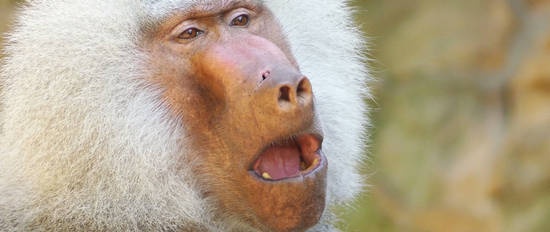 There are about twenty signals in the sound language, each of them carries specific information and has an exact address.
There are about twenty signals in the sound language, each of them carries specific information and has an exact address. In addition to these precise signals, hamadryas still emit many sounds that do not carry specific information. For example, a blissful grunt while searching. Although how to say, maybe this grunting is a signal for a partner and encouraging his actions. Moreover, recently the opinion has been spreading more and more that even seemingly completely neutral sounds, such as rumbling in the stomach, have a signal value. Rumbling helps monkeys in the thickets to determine the location of relatives. Just like the beating of the mother's heart helps the baby to get into the correct position on her body and not to lose the nipple.
In addition to these precise signals, hamadryas still emit many sounds that do not carry specific information. For example, a blissful grunt while searching. Although how to say, maybe this grunting is a signal for a partner and encouraging his actions. Moreover, recently the opinion has been spreading more and more that even seemingly completely neutral sounds, such as rumbling in the stomach, have a signal value. Rumbling helps monkeys in the thickets to determine the location of relatives. Just like the beating of the mother's heart helps the baby to get into the correct position on her body and not to lose the nipple. With the help of his gaze, the leader can silently control all the actions of the herd from a distance.At the same time, he can be far enough away from relatives. All the same, the look will take effect. The secret is in the white areas of the skin above the eyelids. As soon as the monkey raise its eyebrows, that is, simply pull back the skin from the forehead, and the white eyelids stand out clearly on its gray physiognomy. Therefore, a forbidden or threatening gaze is visible far away.
With the help of his gaze, the leader can silently control all the actions of the herd from a distance.At the same time, he can be far enough away from relatives. All the same, the look will take effect. The secret is in the white areas of the skin above the eyelids. As soon as the monkey raise its eyebrows, that is, simply pull back the skin from the forehead, and the white eyelids stand out clearly on its gray physiognomy. Therefore, a forbidden or threatening gaze is visible far away.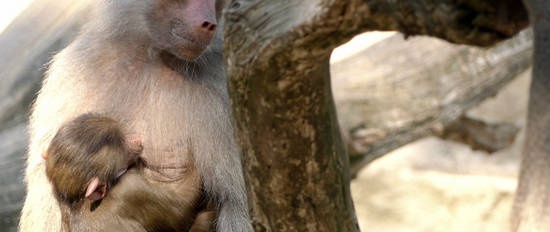 They use their entire body to reach rapport, from the tip of their nose to the tip of their tail.
They use their entire body to reach rapport, from the tip of their nose to the tip of their tail.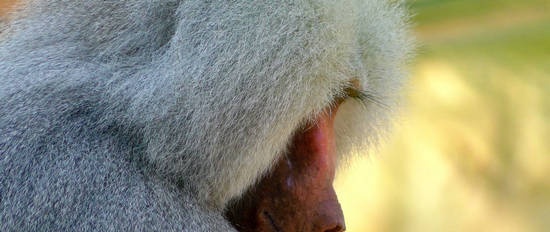 Offer any monkey a treat in front of the leader. She has no right to take a piece. All the tastiest things first of all belong to the leader. Even if he is now, at this moment, and is not in the mood to feast on.
Offer any monkey a treat in front of the leader. She has no right to take a piece. All the tastiest things first of all belong to the leader. Even if he is now, at this moment, and is not in the mood to feast on.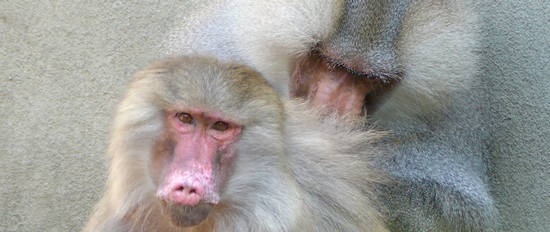 However, there are almost no ethological works concerning the emotions of hamadryas and their means of communication. And we have yet to learn a lot in these matters.
However, there are almost no ethological works concerning the emotions of hamadryas and their means of communication. And we have yet to learn a lot in these matters. Each herd has its own property. One thousand, one and a half hectares. The boundaries of these possessions are conditional. The researchers observed how at a watering hole located in the territory of one herd, the owners met with newcomers. The herds were not mixed. They did not show much hostility to each other.
Each herd has its own property. One thousand, one and a half hectares. The boundaries of these possessions are conditional. The researchers observed how at a watering hole located in the territory of one herd, the owners met with newcomers. The herds were not mixed. They did not show much hostility to each other.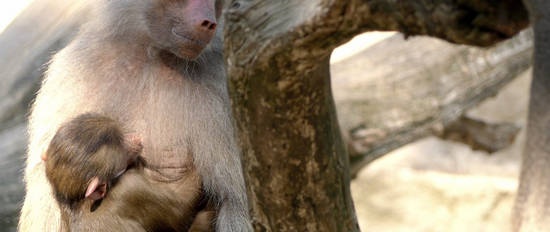 Some scientists consider a herd of hamadryas baboons as a collection of Oikia of the second type.
Some scientists consider a herd of hamadryas baboons as a collection of Oikia of the second type. Even an inexperienced observer will immediately be able to notice in the hamadrilas herd several females who bully their other tribesmen, taking advantage of the special disposition of the leader (or one of the leaders). Among them there is always the “first lady of the court”. Slightly inferior to her second. The third, obeying the first and the second, does not give a descent to everyone else. Etc. The special disposition of the males, however, does not insure them from the cruel spankings that the leader asks his favorites from time to time.
Even an inexperienced observer will immediately be able to notice in the hamadrilas herd several females who bully their other tribesmen, taking advantage of the special disposition of the leader (or one of the leaders). Among them there is always the “first lady of the court”. Slightly inferior to her second. The third, obeying the first and the second, does not give a descent to everyone else. Etc. The special disposition of the males, however, does not insure them from the cruel spankings that the leader asks his favorites from time to time. Happy and carefree time flies by quickly. One-year-old hamadryllas already obey the rules of behavior adopted in the hamadryllas community and master the language of the herd.
Happy and carefree time flies by quickly. One-year-old hamadryllas already obey the rules of behavior adopted in the hamadryllas community and master the language of the herd.